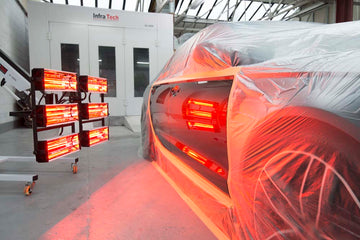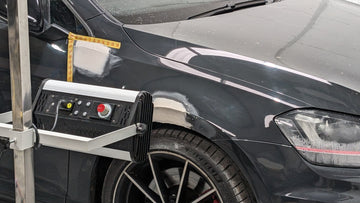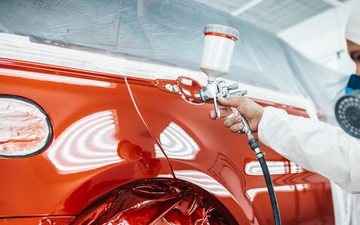
Have you ever wondered what paint curing is, how it compares to drying, and how you can achieve it? Then you’ve come to the right place! We are experts on this subject, especially when it comes to curing within the automotive and aeronautical industries. In this thorough guide, we will provide the answers to these questions and much more. We will explain what paint curing is and provide a run-through of some of the main techniques.
What Is Paint Curing?
First and foremost, let’s begin with this very key question. What exactly is paint curing? Everyone knows what paint drying is, but when it comes to talking about curing, a lot of people are either confused about what it means or assume that it is a complicated way of saying drying. However, as we will focus on in the next section, curing is completely separate from the drying process. Paint curing can be defined as the act of paint becoming fully hardened. Whenever you apply paint to a solid material, it goes through a chemical process of bonding to the surface. Until it has fully bonded and hardened, the paint is not yet cured and that means that it is not yet ready for everyday use.
A vehicle that has just received a paint job or other coating application, for example, should not be out in the open and travelling from place to place. That is because it is not yet ready. During the curing process, it’s important to be gentle with the object’s surface. Until the paint has fully bonded, the surface may be susceptible to scratches or chips, and the paint has a chance of peeling off. During curing, the water in the paint mix evaporates, while other chemicals will react to cause the paint to bond with the surface. As soon as it is fully cured, then the material will be more durable and resistant. This means that you can now use the object, such as a car, for everyday use. You can interact with it, such as by washing or placing objects on the surface, without worrying that damage will occur.
There are several reasons why a curing job may be required. In the automotive industry, this often includes paint jobs and coating applications to repair or improve the appearance of a vehicle. Ceramic coating, for instance, is an increasingly popular choice for making car maintenance easier and for making the car look more premium. However, these benefits are only fully felt when the curing process has finished and the chemicals have successfully mixed.
How Is Paint Curing Different to Drying?
Hopefully, you now have a better understanding of paint curing, but don’t fret if you still don’t fully recognise how it differs to paint drying. In any paint job, the act of paint drying is always the first process that takes place. It occurs right before paint curing and it is significantly quicker. Drying is the process by which the water or solvents evaporate and create a dry outer layer, while curing is when it has achieved maximum hardness. After it has fully dried, the paint may be dry to the touch and not show any signs of wetness, but this can give the illusion that it is ready for use. It is only ready when it has cured and the chemicals have completed their reactions, something that is not easy to see with our eyes. Dried paint may appear safe to touch and it’s likely that you won’t leave marks or mess up the surface, but it won’t yet be durable, resistant or ready for normal everyday use.
If you are impatient and don’t wait for the paint to cure, then this can cause all kinds of problems. Curing can take days or even weeks for 100% competition compared to drying which may last several hours, but it’s important to be gentle and patient during this time. Issues to the paint, such as scratching, chipping or peeling, are possible. Shrinking or clouding can also occur, especially if you apply another paint layer before it has fully cured.
How to Cure Paint Faster
It’s important to be patient and give the paint all the time it needs to cure after drying so that it reaches total hardness. We will talk in detail about the different types of curing techniques in the next section, but first of all, there are some factors that you can influence to cure paint faster. Air circulation is one of the most critical elements that affect how long it takes for paint to cure. When painting indoors and in enclosed areas, it typically takes longer for the paint to dry and cure as less air is circulated in the environment. To quicken the process, you should ensure that a good flow of air reaches the paint.
It’s not rocket science to suggest that the more paint you apply, the longer it will take to cure. Depending on the job and what is most suitable, you should apply a light coat and if required, follow up with another thin coat. However, it’s vital to wait for the paint to dry before applying another coat. Humidity is another element that affects the time it takes for paint to cure. A humid temperature creates moisture which slows the process. You can use a dehumidifier, air conditioning units or open the windows to reduce the level of humid air. Turning up your heating can also help to cure paint faster, but it’s critical to choose the right temperature or the paint may crack or peel by drying too quickly.
Water-based paint may be a preferable option to oil-based paint as it has a lighter texture and a lower pigment content, resulting in a quicker curing process. If painting outside, the weather will play a key role in the time it takes to dry and cure. Rainy and windy days will take much more time than sunny days, so make sure to keep an eye on the weather forecast and plan accordingly. Of course, one of the best ways to cure paint faster is with an infrared heater, which brings us on to the different types of curing methods…
The Main Types of Paint Curing Methods
There are several main methods for paint curing and a suitable choice depends on several factors. The curing time and the quality of the final result, for instance, depends on the technique that you use. The biggest factor in paint curing is without a doubt temperature or a like-minded energy force. Without this, the chemicals simply won’t react. The curing process can also be affected by the type of paint that has been used and the surface that the paint has been applied to.
Below we have rounded up some of the main types of techniques that are often used to aid in the paint curing process.
Convection Curing
Convection is defined as the transfer of heat by circulation of a heated fluid such as air or water. In a paint curing scenario, this could include simply leaving an object to air dry with no special equipment, or it could involve the use of heated air. An example of a convection method for paint curing could also include a convection oven or a spray booth. In both of these examples, objects will be placed inside a relatively small area and contained area where hot air will circulate.
Infrared Curing
Of course, we are specialists with this technique! Infrared curing is where a painted surface will be positioned in front of several infrared panels. These infrared panels will then work to cure the paint with a powerful energy source. Infrared is a type of radiation energy that is invisible to the naked energy, but it is extremely powerful and can reach high temperatures, making it perfect for advanced jobs such as automotive repairs. Infrared guarantees much shorter curing times that a lot of other paint curing techniques, especially convection methods such as air drying. Infrared can penetrate tough surfaces and it heats up whatever surface it is facing, as opposing to heating the surrounding air.
Other Types of Paint Curing
There are a few other types of paint curing, some of unconventional use, that we won’t go into too much detail about in this article. One of these methods is that of ultraviolet rays. Instead of heat energy, UV uses ultraviolet light to cure a surface. UV curing is most commonly used for printing, metal decorations, and artificial fingernails, to name just a few. Another curing method example is that of the rather futuristic electron-beam technology. This is where electron-beam processing is used to emit electrons that can cure an object.
Are You Interested in Infrared Curing?
The best choice of paint curing method really depends on several elements, as discussed in this post. At InfraTech, we really believe in the power of infrared technology for paint curing. That’s why our business is dedicated to manufacturing and selling infrared lamps for paint curing purposes. Our high-ends lamps have shown how effective infrared can be for completing curing jobs with efficiency and quality in mind. Whatever your paint curing needs, visit our product range to see if we have any products that suit what you’re looking for.
For more on paint curing and technology such as infrared, please stay tuned to our blog where we will post the latest InfraTech news, opinion pieces and in-depth guides.




